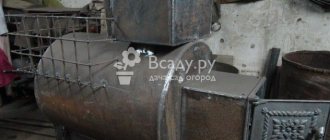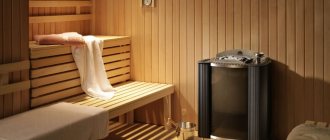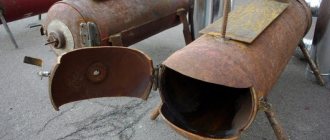Agree, the bathhouse is a sacred place for Russian people, which is treated with special reverence. However, collecting firewood can be a very troublesome and expensive pleasure. Therefore, many consider a gas boiler for a sauna to be the best option - an efficient unit that quickly heats up to the desired temperature.
We will tell you about the advantages of a gas boiler, as well as the features of arranging a gas boiler room in a bathhouse. We'll tell you what you should pay attention to when purchasing it. As a bonus, we will reveal the secret of obtaining a gasification permit.
Advantages and disadvantages of a gas boiler
Most people living in gasified areas choose a gas boiler to heat their baths or saunas. This decision is economically justified.
Advantages of using gas equipment:
- small heating fee;
- no need to stock up on fuel;
- there is no need for a place to store fuel;
- the need for cleaning from ash and coals disappears;
- there are no processed gases in the room;
- small dimensions and weight with maximum power;
- minimum kindling time;
- safety and ease of operation.
A modern gas boiler for arranging your favorite bath or sauna solves several problems simultaneously:
- allows you to get rid of carbon monoxide and the unpleasant odor of scale;
- smoothly heats the air and maintains the temperature;
- Doesn't take up much space.
If you entrust the installation of equipment to specialists and do not interfere with the operation of the control unit and burners, then the risk of fire and carbon monoxide poisoning is minimal. At the same time, the chimney will remain clean.
Gas heating appliances are lighter and more compact than others and have sufficient power to heat a large room
The disadvantage is the high cost. To correctly connect all pipes, electronics, power supply, check the operation of the sensors and ensure tightness, you should seek the help of an experienced technician. You will also have to pay for the services of a contractor knowledgeable in plumbing, electrical and gas supply.
However, all investments will pay off in a couple of years, since the gas model of the boiler is more profitable than other types of heating equipment.
Heating system from the heating main
A private bathhouse can be directly connected to the central heating main. To organize a similar heating option for a bath, you will need to install an additional circuit.
The connection of the circuit to the heating main is carried out in accordance with the design documentation and permits obtained from the relevant authorities.
Choosing this option involves some difficulties:
- the likelihood of accumulation of groundwater in places where pipes are laid;
- the need for additional insulation of the heating main;
- the need to attract professional installers.
Types of gas boilers for baths
All equipment operating on blue fuel is divided into:
- single-circuit - installed in small rooms;
- double-circuit - in addition to heating, they will provide hot sanitary water;
- three-circuit - additionally heat pools or heated floors.
In order to not only heat the bathhouse, but also ensure the supply of hot water, you should choose a double-circuit boiler with a power of 20-30 kW. This power is enough for an area of 200-250 square meters. Water heating rate is 10-14 l/s.
Heats the heating circuit and hot water supply
Boilers can operate both on main gas and bottled liquefied gas. Not all holiday villages are gasified, so the latter type of boiler is optimal for a private bathhouse. Some models are equipped with replaceable nozzles, which allows the equipment to operate on liquefied and main fuel.
Classification of gas boilers:
- by material - metal, stone, brick;
- depending on the fuel used;
- equipped with different tanks for heating water;
- have different types of burners.
Compared to metal stoves, brick and stone stoves take longer to heat up, but they can retain heat longer. A metal boiler is chosen due to its compact size, after which it is lined with brick.
The burners used are atmospheric and inflatable. The atmospheric burner does not require electricity to operate, so it is more economical and at the same time completely silent. It functions due to the air entering the ash pan. The main requirement for boilers with an atmospheric burner is proper ventilation.
The amount of oxygen supplied can be increased by increasing the size of the slot
An inflatable burner is different in that it requires a fan that is powered by electricity to operate. The operating principle is the same: gas is mixed with air to heat it. To make the operation of such a model safer, you need to take care of installing an emergency power source.
Heating system with heated floors
Modern underfloor heating systems are represented by electric and water heated floors. Water floors are an economical and affordable way to heat rooms, requiring high-quality installation, since repairing such a system is quite difficult.
To heat a rest room, dressing room or washing room, it is enough to install heated floors. All work can be done with your own hands. To do this, it is necessary to select pipes of a suitable diameter, calculate the operating resistance of the heating circuit and the required pump power, taking into account the area of the room.
Warm floors can be combined with radiator, electric and air heating.
How does a gas oven work?
The operating principle of the equipment is similar to a classic wood-burning stove. The only difference is the type of fuel. Instead of a firewood compartment, gas boilers have a burner. The gas mixes with oxygen and produces heat.
In some models, the burners are combined with a firebox for firewood. Design Feature:
- gas burner in the housing;
- fuel source;
- in the upper part there is a tray for stones;
- device for removing combustion products;
- thermostat and fuse;
- sealed chamber with processed fuel.
During operation of such a boiler, there is no need to add firewood and monitor the temperature. Thanks to the automatic control system, you can not be distracted from bath procedures.
Water heating system
A practical and affordable way to organize heating of a bathhouse in winter is to install a water system.
Water is used as a coolant, gas, electricity, liquid and solid fuel are used as fuel, and a stove or boiler is used as heating equipment.
Water heating provides quick and uniform heating of bath rooms with the ability to automatically maintain the set temperature.
There are the following options for arranging water heating:
- Radiator heating. Provides for laying pipes along the walls to which water radiators or convectors of the appropriate size and power are connected. The hot coolant from the boiler moves inside the system, providing space heating.
- Underfloor heating. Its operating principle is similar to that in the previous version. The only difference is that the installation of pipes is carried out in a concrete base after its preliminary insulation and waterproofing. This design is of a non-removable type, and therefore requires compliance with installation technology.
How to choose the perfect model?
When choosing a gas boiler for your sauna, you should pay attention to:
- coolant volume;
- area of the heated room;
- requirements for installation and presence of a chimney.
Heating equipment for baths and saunas can be wall-mounted, floor-mounted, or parapet-mounted. Floor-standing models are large in size, have a simple design and operate automatically. Disadvantage: it requires a lot of space for installation.
Wall-mounted models are more compact in size. They are easy to install and equipped with forced smoke removal. Parapet boilers do not require a chimney.
The optimal distance between the wall and the gas boiler is 50 cm
When choosing a boiler, you should pay attention that the high temperature stability of a heating device is not an indicator of quality. You also need to monitor the gas pressure. This is the main criterion when purchasing equipment. A disruption in the supply of blue fuel may be unsafe.
When choosing a gas boiler, it is important to correctly calculate its power. This indicator depends on the area of the heated room. Standard requirements: 0.4 cubic meters requires 252 kilocalories. To calculate the power value, you need to substitute your values.
Useful tips for choosing a gas boiler for a bath and sauna:
- Often the steam room has a small area. In order not to “steal” space with installed equipment, it is better to opt for a medium-sized model.
- The best option is a boiler with an external fuel channel. Advantages: space saving and higher operational safety.
- The lower the gas consumption, the more efficient the equipment and the higher its efficiency. The data can be found in the unit passport.
- Some boiler models operate only on main blue fuel. This should be taken into account if you plan to use liquefied bottled gas.
- When planning to cover the boiler with bricks, you need to pay attention to how many stones the power of the unit is designed for.
It is preferable to purchase a boiler from well-known manufacturers. The best domestic manufacturers: Ermak, KUTKIN, Termofor.
Combination is the best option
For a long time now, experienced bathhouse attendants have not limited themselves to just one type of fuel; it is much more profitable to combine them in one device.
Option one . A combination of an electric boiler and a pellet boiler, with the former being used as a backup. The disadvantage of this combination is that at first you will spend a lot of money on purchasing both types, and the room itself for the boiler room should be quite spacious. But the advantages of such a combined model are extremely pleasant: the price of the binder is much lower than that of a diesel engine, and you can set up the entire boiler room for fully automated operation for a period from a week to a whole month. In this case, you can set the electric boiler to operate at night using a two-tariff meter.
Option two . A combination of a gas boiler as the main one and an electric one as the backup one. Gas has a lower cost compared to the same diesel engine, but with its help (especially if the area where the bathhouse is built is gasified) it is also possible to fully automate the boiler room. The only drawback of such a system is the expensive gas tank, and the fact that it will need to be buried at a distance of 15 meters from the house if there is no gas source nearby. Although some install a multi-cylinder unit, which ends up costing them less, it still needs to be taken to a gas station from time to time. But generally speaking, such a combined system is one of the safest, most convenient and profitable.
Option three . Also a good option is to combine a coal boiler with an electric one. However, to do this you will need an additional tank. After all, most often an electric boiler consists of just a few heating elements that heat water, so a second circuit should be made in a coal boiler, a pipe should be welded into it to supply circulation to the system in the container, and the heating elements should be built directly into the container itself. You can also use two types of heaters at the same time. This system makes it possible to use both types of heating economically. And in winter, when it’s especially good to take a steam bath, you won’t have to heat up a huge amount of coal - you can connect electric heaters.
Source of the article: https://banyamsk.ru/proekty/bani-s-kotelnoj/
Safety and Installation Requirements
Since gas is used for operation, you should be as careful as possible during operation.
Necessary:
- monitor the wear of all equipment parts;
- regularly check the readings of the gas analyzer and other devices;
- Only trust a specialist to replace parts.
Savings when purchasing, installing and operating gas equipment can lead to dire consequences.
Requirements for the room where gas equipment is planned to be installed: no high humidity, no accumulation of dust, limited access for children.
Before a gas boiler room is installed in a sauna or bathhouse, you need to study the rules for safe installation:
- the height of the room must be at least 2.2 m;
- All doors must be opened outwards;
- It is necessary to have a window and exhaust ventilation;
- absence of flammable structures near the equipment (minimum distance - 0.5 m);
- if the walls of the room are made of fire-hazardous material, when installing the equipment, an indentation of at least half a meter should be made (the use of a fire-resistant barrier or heat-resistant screen is allowed);
- a hole for a rectangular burner (height - 48-55 cm, width - 35-45 cm);
- to prevent gas leakage, it is recommended to install a special sensor that will operate when the burner goes out;
- the smoke exhaust pipe should not pass through living rooms;
- the stove must have a metal base that will protrude at least 10 cm;
- To prevent the occurrence of condensation, the chimney must be made of stainless steel.
If the site is not gasified, then forced removal of combustion products should be organized. To maintain high temperatures, high-quality thermal insulation of the room is necessary.
The optimal solution would be to use foil insulation. It should be noted that heat loss increases in the presence of windows and uninsulated doors.
Features of gasification of a bath
Russian government decree No. 509 of 2008 states that gasification of a bathhouse is allowed. The only condition is that its use for commercial purposes is prohibited.
If the boiler is equipped with an atmospheric burner, the inspector will check the ventilation device and draft
The project should include:
- the presence of a separate entrance (heat-resistant materials are used to make the door);
- availability of fire extinguishing and alarm systems;
- the equipment must be industrially produced and have a quality certificate;
- It is mandatory to have a ventilation system and a carbon monoxide detector.
Practice shows that the chance of obtaining permission to gasify a bathhouse increases if all work is carried out by specialists competently and efficiently. After the building of a bathhouse or sauna is built, it should be registered with the BTI. The next stage is a trip to the city gas supply office, where an application for gasification is written.
When the application is reviewed, an inspector will visit the gasification site. As a result of the inspection, changes may be required (installation of additional ventilation, alteration of the chimney). When permission is received, all that remains is to connect the equipment and insulate the bathhouse building.
After selecting and installing a gas boiler in the bathhouse, you can enjoy the result of your labor. Money and time costs are compensated by maximum comfort and safety. After all, modern equipment allows you to create an optimal balance between temperature and humidity, does not dry out the air and is ideal for lovers of a traditional bath.
Conclusions on the topic
Gas boilers for saunas are more expensive than wood stoves. However, the cost is offset by many benefits. You no longer need to prepare firewood and monitor the temperature in the room. In addition, the gas boiler is easy to use and completely safe.
The disadvantages of the equipment are too insignificant in comparison with the advantages, so they can be neglected. It is important to observe safety precautions during operation and trust the installation of the boiler to professionals.
If you have experience using a gas boiler for a bath, please share your impressions. Which company's equipment do you consider more reliable? Write your recommendations in the comments and share photos of arranging your own bathhouse.











